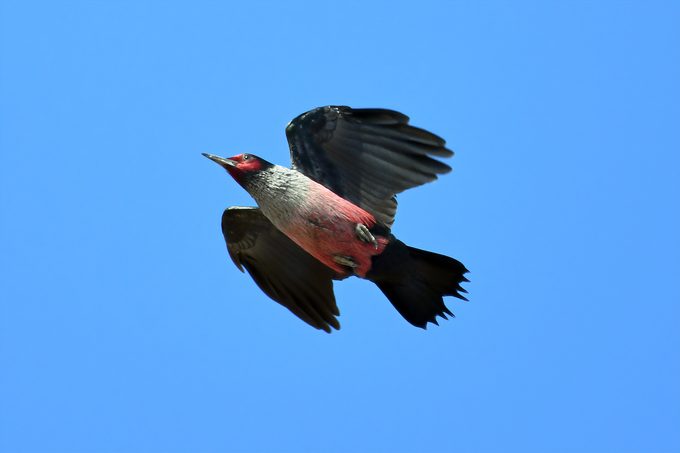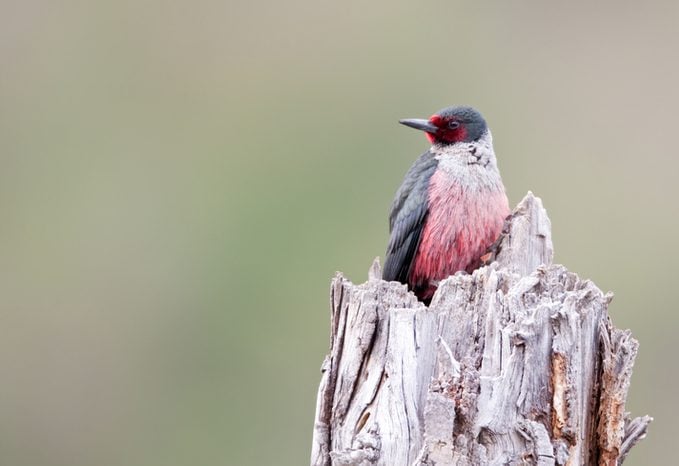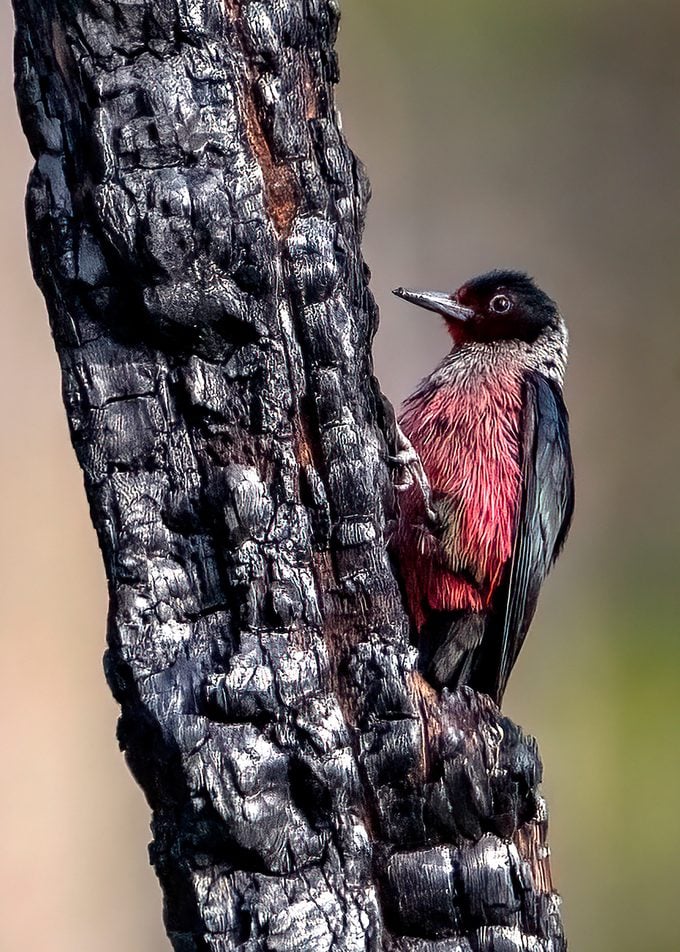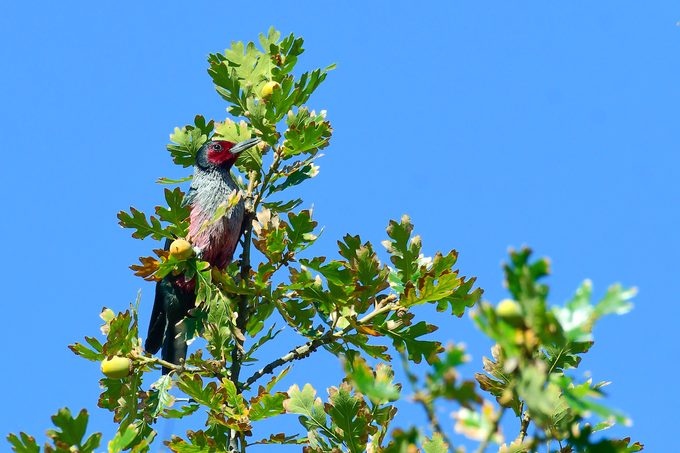Head West to Spot a Lewis’s Woodpecker
Updated: Mar. 15, 2024
When you spot a beautiful woodpecker that doesn’t act like one, there’s a good chance it is the agile and versatile Lewis’s woodpecker.
While other woodpeckers hammer out their meals from trees or buildings, the Lewis’s woodpecker employs a more graceful yet nontraditional technique. “They catch insects on the wing,” says wildlife biologist Kaly Adkins, who works with the Oregon Department of Fish & Wildlife. “They are super fascinating because they feed like a flycatcher and fly like a crow.”
On This Page
What Does a Lewis’s Woodpecker Look Like?

With its slow wing beats and long glides, this 10-to-11-inch-long bird might be mistaken for a crow or jay until its beautiful coloration is visible. “They have brilliant, iridescent colors,” Kaly says. “There is black and green plumage on their back to blend in with burnt trees. And they are cute with those pink bellies.”
Males and females look alike, although the males are slightly larger. Both share the black bill, gray collar and red on their faces, as well as relatively long wings and tails.
Lewis’s woodpeckers were described by, and later named for, Capt. Meriwether Lewis of the Lewis and Clark expedition who observed them in 1806 in western Montana. The species was initially known scientifically as Picus torquatus, meaning “woodpecker with a necklace.”
Nesting Habits

Lewis’s woodpeckers lack the heavy skull structure of other woodpeckers and are predominantly secondary cavity nesters in decaying trees, which is one reason it’s beneficial for homeowners in their range to allow standing dead or decaying trees to remain whenever possible.
“They recycle a lot of flicker nests,” Kaly says. Lewis’s woodpeckers nest between mid-April to early June. They sometimes expand the cavity and line it with bark chips, where they’ll raise one clutch with five to nine eggs. Both parents incubate the eggs and care for the young.
What Does a Lewis’s Woodpecker Eat?

Lewis’s woodpeckers are omnivores, but their eating habits focus on what’s available. In their range, which covers areas in the western half of the U.S. and expands into British Columbia, they focus mainly on insects in the warmer months, sometimes adding fruit to the menu. They gather and store acorns and nuts in tree limb crevices for later use when insects are not prevalent.
Unlike other woodpeckers, Lewis’s often perch on a branch and swoop after flying insects.
“Flycatching from atop a 100-foot snag on the shoulders of Mount Jefferson in Oregon, the aerial maneuvers of Lewis’s woodpeckers are stunning. The iridescent green, black, red and silver colors make the Lewis’s an outstanding resident of central Oregon and the Cascades. This particular woodpecker (above) was enjoying bugs after a burn,” says Birds & Blooms reader Douglas Beall of Camp Sherman, Oregon.
Migration and Range

“For many species, migration is well defined, but we know Lewis’s woodpeckers are more versatile in their migration strategy,” Kaly says. In the fall some Lewis’s in the northern range migrate south, while others, particularly in temperate areas along the West Coast, remain in their home range the entire year.
There’s a strong connection between these woodpeckers and wildfires in their range: The open post-fire landscape often means more aerial hunting opportunities. Plus, standing dead trees provide important nesting opportunities for them.
Sound and Calls
Bird songs courtesy of the Cornell Lab of Ornithology
About the Expert
Kaly Adkins is a wildlife and conservation biologist who works with the Oregon Department of Fish & Wildlife. Kaly has also studied movement and activity of rare Sierra Nevada red foxes, bats and wolverines.
Sources
- Joint Fire Science Program – Fire Science Brief
- Cornell Lab of Ornithology
- Washington NatureMapping Foundation
- Lewis & Clark Trail Heritage Foundation
- eBird
- U.S Geologicial Survey – Mount Jefferson
Why Trust Us
For nearly 30 years, Birds & Blooms, a Trusted Media Brand, has been inspiring readers to have a lifelong love of birding, gardening and nature. We are the #1 bird and garden magazine in North America and a trusted online resource for over 15 million outdoor enthusiasts annually. Our library of thousands of informative articles and how-tos has been written by trusted journalists and fact-checked by bird and garden experts for accuracy. In addition to our staff of experienced gardeners and bird-watchers, we hire individuals who have years of education and hands-on experience with birding, bird feeding, gardening, butterflies, bugs and more. Learn more about Birds & Blooms, our field editor program, and our submission guidelines.






















